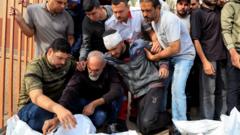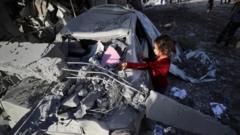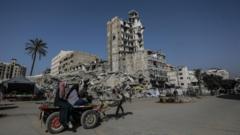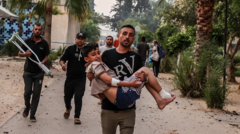Israel is preparing several humanitarian aid distribution centers in Gaza as a US-supported plan unfolds, despite widespread condemnation of its blockade and allegations of using starvation as a military strategy. The UN and various humanitarian organizations have voiced their concerns about the plan, emphasizing that it could neglect the most vulnerable populations in the region.
Israel Begins Construction of Humanitarian Aid Centers Amid Controversy Over Blockade
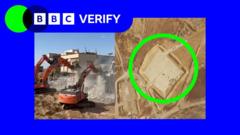
Israel Begins Construction of Humanitarian Aid Centers Amid Controversy Over Blockade
New satellite imagery reveals construction of aid distribution hubs in Gaza, as humanitarian concerns rise in response to a controversial Israeli blockade.
Israel has commenced construction of humanitarian aid distribution sites in Gaza as part of a controversial new plan aimed at alleviating the severe humanitarian crisis in the region. Satellite imagery analyzed by BBC Verify reveals that several locations have been cleared and developed for this purpose, despite ongoing condemnation from the United Nations and humanitarian agencies regarding Israel's blockade, which has halted food and medical supplies since March.
Israeli officials have asserted that the blockade is a strategic measure to pressure Hamas for the release of hostages, while also accusing the group of siphoning off aid — a claim Hamas vehemently denies. The UN has reported alarming shortages of essential supplies, warning that the approximately 2.1 million inhabitants of Gaza are facing an imminent threat of famine due to the restrictions imposed on aid.
In a bid to implement the aid distribution plan, the US has indicated that it is establishing a new system involving several humanitarian hubs managed by private companies and safeguarded by security forces, including the Israeli military. While Israel has yet to disclose the precise locations of these planned hubs, sources familiar with Israeli briefings have indicated that the majority will be situated in southern Gaza, along with one near the Netzarim Corridor.
The Gaza Humanitarian Foundation — responsible for executing the aid strategy — stated that its operations would begin before the end of May, initially targeting around 1.2 million people, which constitutes less than 60% of Gaza's total population. They are now advocating for Israel to permit aid delivery through traditional channels until their distribution centers are operational.
However, UN agencies have rejected participation in the proposed setup, asserting that it undermines basic humanitarian principles. Olga Cherevko, representative of the UN's Office for the Coordination of Humanitarian Affairs (OCHA), criticized the plan for potentially aggravating the plight of the vulnerable as it restricts access to essential supplies.
Critics, including Oxfam's Bushra Khalidi, have dismissed the plan as a "farce," arguing that no logistical arrangements can mitigate what they view as Israel's broader strategy to displace populations and utilize starvation as a tactic of warfare.
The satellite images documented by BBC Verify show significant progress in constructing one site near IDF operational bases, complete with defensive barriers and staging areas for potential aid distribution. Additional imagery indicates that the aid centers are strategically located near established IDF positions, further underscoring Israel's military oversight of the anticipated operations.
Meanwhile, the humanitarian community continues to express grave concern over the blockade's implications and remains committed to advocating for unimpeded access to aid for all in Gaza amidst ongoing tensions in the region.



